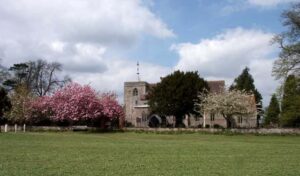•
(Caution: Contains spoilers for Episode: S09E05: Four Funerals and a Wedding)
Diesen Beitrag gibt es auch auf Deutsch.
•
Joyce’s mother, Muriel, is a guest at the Barnaby home. Much to the chagrin of Tom Barnaby, who, while not getting along badly with his mother-in-law, does not appear to have a warm relationship with her either. Nevertheless, he gets the conversation going at home after work. Cully wants to go to Broughton for the Skimmington Fayre. Her parents are less than enthusiastic, but her grandmother is more so.
A little fun fact at this point: The title of the episode alludes to the romantic comedy “Four Weddings and a Funeral”. It’s easy to see why the title was a bit changed. But did you know that there are several actors who appear in both the 1994 film and this Midsomer Murders episode?
One Ride to Rule Them All

In 1916, in the middle of the First World War, there was an influential and important landowner in Broughton. He enlisted all the men in his company and… in one battle they all died ‘overnight’.
Dozens of families were left with no income or livelihood. So the widows formed a self-help group, the Skimmington Society. They were able to help many, but developed a strong dislike, even hatred, of men.
And this battle of the sexes is what the Skimmington Fayre is all about, especially the Skimmington Ride. This is underpinned by the fact that the Skimmington Society meeting takes place in Pankhurst Hall, where a banner reading ‘Deeds not Words’ hangs from the ceiling. This is a reference to Emmeline Pankhurst and her daughter Christabel, who founded the Women’s Social and Political Union (WSPU) in 1903. Under the motto “Deeds not Words”, women joined together to fight for women’s right to vote through militant action.
A model for the Skimmington Society? Somehow it is, although the Skimmington Society does not engage in militant, but only exposing actions.
Emmeline & Christabel Pankhurst
Militant action of the WSPU meant the destruction of buildings through smashing windows, arson or explosions. At a demonstration following the failure of the Women’s Suffrage Bill in Parliament in 1910, the police reacted so aggressively and with sexual assaults that the day went down in history as Black Friday. Many women were briefly arrested. Emmeline’s sister Mary Jane Clarke died as a result of abuse on Christmas Day 1910.
On 3 April 1913, Emmeline Pankhurst was sentenced to three years in prison for plotting to bomb the country home of the Chancellor of the Exchequer, David Lloyd George. The sentence led to violent street battles between women’s rights activists and the police, as well as further attacks on public institutions and prominent figures, including Prime Minister Herbert Asquith. The actions, which spread across the country in the form of arson and bombings, were described in the press as a ‘reign of terror’.
Pankhurst was released on 12 April 1913 after a hunger strike due to her poor health. The unrest continued with bombings, acid thrown into letterboxes and church arsons. Sympathisers sang “God save Emmeline Pankhurst” in large churches such as St Paul’s and Westminster Abbey, while elsewhere churches were set alight.
Imprisonment as part of the marketing strategy
This caused a rift in the Pankhurst family because, unlike Christabel, Emmeline’s daughters Sylvia and Adela were far from happy with the WSPU restricting itself to upper and middle class women on the one hand and using such militant, terrorist tactics on the other. Emmeline and Christabel, however, felt that it was essential in order to achieve the desired visibility and pressure on politics. Sylvia then joined the Socialist Party. Adela was sent to Australia by her mother.
The members of the WSPU were repeatedly arrested, convicted and imprisoned – deliberately, because as prisoners the women went on hunger strikes and attempts were made to force-feed them. It was a very humiliating treatment which the WSPU used as a marketing ploy.
The government responded by passing the Prisoners (Temporary Discharge for Ill Health) Act 1913. This stated that if a prisoner became so ill as a result of their hunger strike that they were in danger of dying, they would have to be released, but could be re-imprisoned to serve out their sentence once they recovered. The law quickly became known colloquially as the ‘Cat and Mouse Act’.
Radical shift 1
But then the First World War began and the WSPU immediately ended its campaign against the government, supported it and called on women to do their part in the war effort. Shortly after the First World War, the Representation of the People Act 1918 reformed the franchise: All men over 21 and all women over 30 could vote. Not yet equality, but a first step.
And the Pankhursts resumed their militant activities with the WSPU? On the contrary, they cosy up with the Conservative Party. Emmeline feared the Socialist Party (of which her daughter Sylvia was a member) so much that she became a member of the Conservative Party. And daughter Christabel stood in the 1918 general election as the Women’s Party candidate for the Conservative Party’s alliance with Lloyd George – Lloyd George, of all people, whose country house had been bombed by the Pankhursts five years earlier.
Christabel’s campaign was nationalistic: Britain for the British; Germany must pay for the war (and ideally be destroyed by it). But the Labour candidate won the constituency.
Radical shift 2
Emmeline and Christabel did not live to see the equalisation of the franchise in England through the revision of the Representation of the People Act 1928 in England. Emmeline had died a few weeks earlier and Christabel had lived in the USA since 1921. Here she was a respected member of the Seventh-day Adventist Church. Here she was not active as a suffragette, but lectured and wrote about biblical prophecy and the role of women in God’s plan, which was inundated with an imminent apocalypse and the return of Christ. Her life was a curious mixture of suffragette, evangelical Christian and overly clichéd English lady.
Christabel died 30 years after her mother. To commemorate both Pankhursts, a bronze statue of Emmeline was erected near the Houses of Parliament (Victoria Tower Gardens) in 1930, to which Christabel was added in 1959. (The memorial to Emmeline and Christabel Pankhurst has been on the National Heritage List since 1970. In addition, two blue plaques to Emmeline and Christabel Pankhurst were unveiled in 2006 and 2018 in Clarendon Road, Notting Hill and Russell Square (both in London).
Widows after the Great War
As mentioned at the beginning, the reason for the formation of the Skimmington Society was not women’s suffrage, but the death of many men. It is likely that by this time almost every family in Broughton had lost the man who had previously provided the money for their food and livelihood.
During the First World War, an estimated three to four million women were widowed. In the UK there were around 240,000 women. Most of them already had children and now had to support themselves. They received a state widow’s pension. But the pension was never enough to cover their daily needs, so they had to work as single parents. In fact, widows were expected to wear mourning clothes and respect a period of several months of widowhood.

Widows were generally suspected by moralists of living in social disorder, which might contribute to the military defeat of their country. And if they remarried, they would lose their widow’s pension? Oh, it was much worse than that: the mere suspicion of ‘relationships with men other than close relatives who might be expected to provide for them, the quality of their housekeeping and, where relevant, the quality of their parenting’. Pensions would be withdrawn if evidence came to light that these standards were not being maintained. Given that ‘evidence’ of falling standards could include neighbourhood gossip, it was not uncommon for pensions to be withdrawn.
In addition, pensions would always be withdrawn if a widow remarried or entered into a relationship with another man, as he would be expected to provide for her and any children”. (Quoted from the War Widow Association on the National Army Museum’s website)
Brill and Broughton
Most of the filming took place in Brill, Buckinghamshire, whose windmill is a recurring location for Midsomer County. The site is recorded in the Domesday Book, but before that Edward the Confessor had a palace here in Anglo-Saxon times. It remained in royal hands for centuries. Converted into a royalist garrison by Charles I during the Civil War, it was destroyed by Parliamentarians in 1643. The Reverend Gant’s Church is the Chapel of All Saints in Brill and belonged to the Priory of St Frideswide, Oxford, until the Dissolution of the Monasteries. It was also the terminus of the Brill Tramway, which ran from Fletcher’s Cross Station, er, sorry, Quainton Road to Brill.
It is possible that a self-help group such as the Skimmington Society also existed in Brill, Buckinghamshire. Unfortunately I have not found any evidence of this. Nor in Beaconsfield (Buckinghamshire), Dorchester (Oxfordshire) and Little Missenden (Buckinghamshire), where small parts of Broughton were also filmed. (I’m happy to receive tips in the comments or by email).
Read more about Midsomer Murders & History
The Chronology of Midsomer County by Year or by Episodes
Deep Dives into Midsomer & History
This is an independent, non-commercial project. I am not connected to Bentley Productions, ITV or the actors.

Literature
- Beckett, Ian F. W.: Buckinghamshire in the Great War. A research framework. In: Records of Bucks 57 (2017). P. 191-203.
First published on MidsomerMurdersHistory.org on 16 February 2024.
Updated on 6 November 2025.


4 thoughts on “Deeds Not Words”